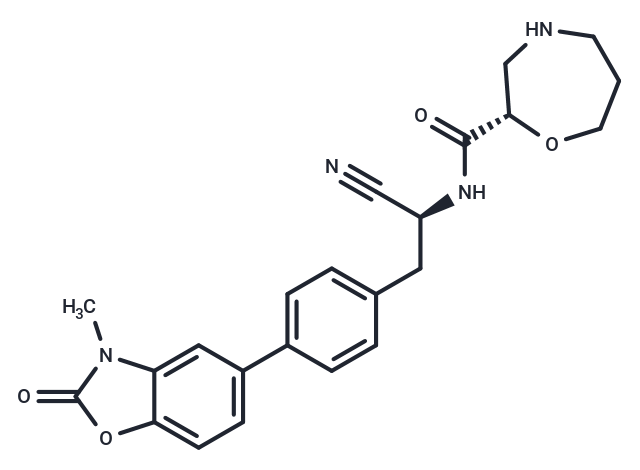Shopping Cart
Remove All Your shopping cart is currently empty
Your shopping cart is currently empty
Brensocatib (AZD7986) is a Dipeptidyl peptidase 1 (DPP1) inhibitor (pIC50s: 6.85, 7.7, 7.6, 7.8, and 7.8 in human, rat, mouse, rabbit, and dog, respectively).

| Pack Size | Price | USA Warehouse | Global Warehouse | Quantity |
|---|---|---|---|---|
| 1 mg | $52 | In Stock | In Stock | |
| 5 mg | $123 | In Stock | In Stock | |
| 10 mg | $198 | In Stock | In Stock | |
| 25 mg | $397 | In Stock | In Stock | |
| 50 mg | $575 | In Stock | In Stock | |
| 1 mL x 10 mM (in DMSO) | $135 | In Stock | In Stock |
| Description | Brensocatib (AZD7986) is a Dipeptidyl peptidase 1 (DPP1) inhibitor (pIC50s: 6.85, 7.7, 7.6, 7.8, and 7.8 in human, rat, mouse, rabbit, and dog, respectively). |
| Targets&IC50 | DPP1:pIC50: 6.85(human), DPP1:pIC50: 7.6(mouse), DPP1:pIC50: 7.7(rat), DPP1:pIC50: 7.8(dog), DPP1:pIC50: 7.8(rabbit) |
| In vitro | AZD7986 is stable in the propionaldehyde reactivity assay, with a half-life over 50 h. After differentiation in the presence of AZD7986 (38 pM to 10 μM), concentration-dependent decreases in cell lysate enzyme activity are observed for DPP1, as well as for all of the three NSPs, NE, Pr3, and CatG. AZD7986 inhibits activation of all three NSPs in a concentration-dependent manner, with pIC50 values of around 7 for all three NSPs. The reduction of the activities is almost complete, with NE, Pr3, and CatG activities reduced to 4 to 10% of control at 10 μM AZD7986. |
| In vivo | AZD7986 shows good stability in plasma, with a half-life of >10 h. AZD7986 inhibits activation of Pr3 and NE, but not CatG, in bone marrow cell lysates in a dose-dependent manner in vivo. |
| Kinase Assay | Activation of neutrophil serine proteases is assessed in vitro using primary bone marrow-derived CD34+ neutrophil progenitor cells. Cells are cultured in media supplemented with rhSCF and rhIL-3 for 7 days, and then for a further 7 days in the presence of G-CSF and different concentrations of AZD7986 (38 pM to 10 μM). After harvesting and lysis with 10% Triton X-100 buffer, cell lysates are kept at -20°C until NSP activity analysis. |
| Cell Research | Cellular potency is studied using the DPP1-expressing monocytic U937 cell line. Briefly, cells grown in RPMI are plated on 384-well polypropylene v-bottom plates at a density of 5×10^5 cells/mL per well. Added to this is 10 μL of AZD7986 at 37°C for 60 min, followed by 350 μM Gly-Phe-AFC. The well fluorescence is read using a multilabel plate reader. Data are analyzed to calculate pIC50 values. |
| Animal Research | Rats are used for the in vivo study. Naive rats are dosed orally twice daily with AZD7986 at 0.2, 2, and 20 mg/kg/day for 8 days. At termination, bone marrow is taken by femural aspiration for neutrophil serine proteases activity analysis using commercial synthetic peptide substrates. |
| Synonyms | INS 1007, AZD7986 |
| Molecular Weight | 420.46 |
| Formula | C23H24N4O4 |
| Cas No. | 1802148-05-5 |
| Smiles | Cn1c2cc(ccc2oc1=O)-c1ccc(C[C@H](NC(=O)[C@@H]2CNCCCO2)C#N)cc1 |
| Relative Density. | no data available |
| Color | Yellow |
| Appearance | Solid |
| Storage | Powder: -20°C for 3 years | In solvent: -80°C for 1 year | Shipping with blue ice/Shipping at ambient temperature. | |||||||||||||||||||||||||||||||||||
| Solubility Information | DMSO: ≥100 mg/mL (237.83 mM), Sonication is recommended. H2O: Insoluble | |||||||||||||||||||||||||||||||||||
| In Vivo Formulation | 0.5% HPMC and 0.1% Tween 80 in 0.1 M citrate buffer (pH=3): 1 mg/mL (2.38 mM), Suspension 10% DMSO+40% PEG300+5% Tween 80+45% Saline: 2 mg/mL (4.76 mM), Sonication is recommended. Please add the solvents sequentially, clarifying the solution as much as possible before adding the next one. Dissolve by heating and/or sonication if necessary. Working solution is recommended to be prepared and used immediately. The formulation provided above is for reference purposes only. In vivo formulations may vary and should be modified based on specific experimental conditions. | |||||||||||||||||||||||||||||||||||
Solution Preparation Table | ||||||||||||||||||||||||||||||||||||
DMSO
| ||||||||||||||||||||||||||||||||||||
| Size | Quantity | Unit Price | Amount | Operation |
|---|

Copyright © 2015-2026 TargetMol Chemicals Inc. All Rights Reserved.